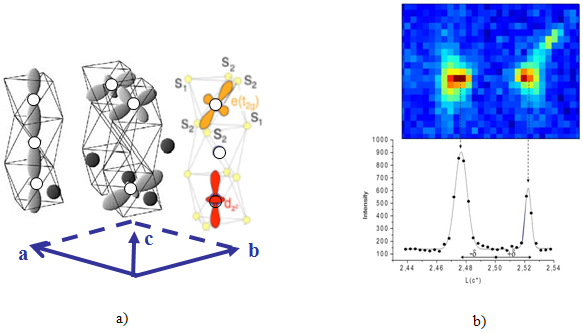Studies of tiny structural variations near the quantum critical point for the metal BaVS3.
We now know that the presence of strong correlations between electrons can induce unexpected properties in a material such as high critical temperature superconductivity or giant magnetoresistance. To this is added the fact that electrons can come from different orbitals, have a spin, and are immersed in an atomic structure with which they interact just as strongly. A combination of these parameters can lead to the stabilization of even more remarkable ground states. In order to better understand this subtle balance, X ray diffraction analyses under high pressure and low temperature have been carried out on a model material.
The balance resulting of the interaction between the numerous electronic, stuctural and magnetic degrees of freedom in a material is easily modified by the application of external parameters. In particular, hydrostatic pressure can have a drastic effect as it alters the distance between atoms and therefore the overlap between orbitals.
In this context, the compound BaVS3 is a model system with a very simple crystallographic structure of Vanadium chains (figure a), yet having a complex electronic structure containing two types of electrons. Half of the Vanadium 3d electrons are quasi-free and provide the electrical conductivity. These come from the dz² orbitals of Vanadium strongly overlapping in the direction of the chains (left on figure a). The other half of the electrons, coming from the e(t2g) orbitals, are localized (middle of figure a). At low temperatures, a metal-insulator transition occurs. The compound becomes insulating because the dz² electrons pair up to form a condensate of lower energy electron-hole pairs. They undergo what is called a Peierls electronic and structural transition, named after the physicist who predicted it in the 1950s and thus explained why carrots are not metallic!
Under the effect of hydrostatic pressure, measurements of transport properties in BaVS3 show that the insulating phase gradually disappears giving rise to a quantum critical point where the restored metallic state is no longer of the Fermi-liquid-type. This quantum critical point corresponds to a pressure-induced quantum phase transition at zero temperature. In order to have a better understanding of this phase transition, researchers at the Laboratoire de Physique des Solides (mixed research unit between the CNRS and Paris Sud University), in collaboration with researchers of the CRISTAL and PSICHE beamlines (SOLEIL) and the Ecole Polytechnique Fédérale in Lausanne, have developed a high performance X-ray diffraction set-up. They are able to carry out experiments under pressure (2 GPa) and at very low temperatures in order to probe not only the structure of BaVS3 near the quantum critical point but also its minute variations associated with the Peierls transition.
This experiment highlighted a still unknown phase of BaVS3, where the Peierls transition is modified and induces modulation of the atomic positions, which become incommensurate with the lattice spacing (Figure b). These results, in the face of theories taking into account the coupling of different degrees of freedom of the system, allowed researchers to propose that the electron-hole pairs formed with the dz² orbitals during the Peierls transition become more unstable as a result of the pressure. The pressure does indeed favor hybridization of the paired dz² electrons with unpaired et2g electrons. This causes a reduction in the lifetime of electrons in the dz² orbital state and eventually permanently prohibits their electron-hole pairing in the Peierls condensate, leading to the quantum critical point.
The ambitious aim of this research collaboration is to try to measure the structural fluctuations preceding the Peierls transition and to evaluate their possible relationship with quantum fluctuations expected near the quantum critical point.

Figure: a) hexagonal lattice of chains of VS6 octahedra in BaVS3. Two types of orbitals are represented: delocalized dz² (left chain) and localized et(2g) (middle chains), with their orbital ordering in the Peierls transition (right chain).
b) X-ray diffraction image obtained at 15K and 1.5 GPa showing the splitting of a low pressure super-structure reflection associated with the Peierls transition. This splitting is the signature of the incommensurate aspect of the new high pressure phase.
